Related Research Articles
Route 5 is a 3.18-mile (5.12 km) state highway located entirely in Bergen County, New Jersey, United States. It runs from U.S. Route 1/9 (US 1-9) in Ridgefield east down the New Jersey Palisades to end at County Route 505 at the Hudson River in Edgewater. The route is a two- to four-lane undivided highway its entire length, passing mostly through wooded residential neighborhoods. The route passes under Route 63 in Palisades Park, with access to that route provided by Bergen Boulevard, and intersects the southern terminus of Route 67 in Fort Lee.

Ridgefield is a borough in Bergen County, New Jersey, United States. As of the 2010 United States Census, the borough's population was 11,032, reflecting an increase of 202 (+1.9%) from the 10,830 counted in the 2000 Census, which had in turn increased by 834 (+8.3%) from the 9,996 counted in the 1990 Census.

Hackensack is a city in Bergen County in New Jersey, United States, and serves as its county seat. The area was officially named New Barbadoes Township until 1921, but it was informally known as Hackensack since at least the 18th century. As of the 2010 United States Census, the city's population was 43,010, reflecting an increase of 333 (+0.8%) from the 42,677 counted in the 2000 Census, which had, in turn, increased by 5,628 (+15.2%) from the 37,049 counted in the 1990 Census.

The Hackensack River is a river, approximately 45 miles (72 km) long, in the U.S. states of New York and New Jersey, emptying into Newark Bay, a back chamber of New York Harbor. The watershed of the river includes part of the suburban area outside New York City just west of the lower Hudson River, which it roughly parallels, separated from it by the New Jersey Palisades. It also flows through and drains the New Jersey Meadowlands. The lower river, which is navigable as far as the city of Hackensack, is heavily industrialized and forms a commercial extension of Newark Bay. Once believed to be among the most polluted watercourses in the United States, it staged a modest revival by the late 2000s.
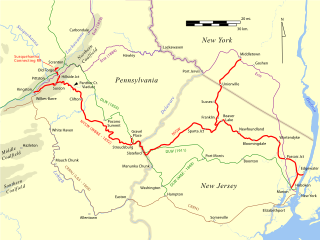
The New Jersey Midland Railway was a 19th-century predecessor to the New York, Susquehanna and Western Railway (NYS&W) that operated in Northern New Jersey and Orange County, New York.
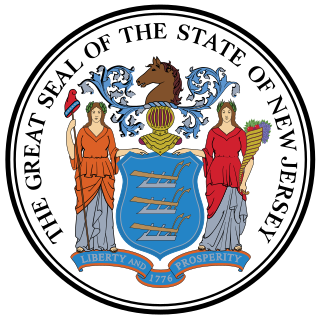
The New Jersey Senate was established as the upper house of the New Jersey Legislature by the Constitution of 1844, replacing the Legislative Council. There are 40 legislative districts, representing districts with average populations of 210,359. Each district has one senator and two members of the New Jersey General Assembly, the lower house of the legislature. Prior to the election in which they are chosen, senators must be a minimum of 30 years old and a resident of the state for four years to be eligible to serve in office.
New Barbadoes Township was a township that was formed in 1710 and existed in its largest extent in pre-American Revolutionary War times in Bergen County, New Jersey. The Township was created from territories that had been part of Essex County that were removed by royal decree and added to Bergen County. After many departures, secessions and deannexations over the centuries, New Barbadoes Township exists today as Hackensack, which adopted its present name in 1921.
Ridgefield Township was a township that existed in Bergen County, New Jersey. The township was created in 1871, when Hackensack Township was trisected to form Palisades Township in the northernmost third, Englewood Township in the central strip and Ridgefield Township encompassing the southernmost portion, stretching from the Hudson River on the east to the Hackensack River, with Hudson County to the south. Much of the area had been during the colonial area known as the English Neighborhood. As described in the 1882 book, History of Bergen and Passaic counties, New Jersey,
Ridgefield is the first township in Bergen County which the traveler enters in passing up the Palisades. His first impressions are much like those of old Hendrick Hudson in speaking of a wider extent of country: "A very good land to fall in with, and a pleasant land to see." The valley of the Hackensack invited early settlers in the seventeenth century, and the valley of the Overpeck Creek, a navigable arm of the Hackensack, also attracted settlers quite as early in this direction. Sloops and schooners can pass up this creek nearly to the northern boundary of the township. Ridgefield is bounded on the north by Englewood, on the east by the Hudson, on the south by Hudson County, and on the west by the Hackensack River. The southern boundary is less than two miles in extent, and the northern less than four, and the length of the township from north to south does not exceed four miles. Bellman's Creek, forming part of the southern boundary, the Hackensack, the Overpeck, the Hudson, with more than a dozen other smaller streams and rivulets, bountifully supply the whole township with water. From the western border of the Palisades the land descends to the Overpeck, forming a most beautiful valley, with the land again rising to a high ridge midway between the Overpeck and the Hackensack. From this long ridge, extending far to the north beyond this township, it took its name of Ridgefield.
The New York, Susquehanna and Western, formerly the Midland Railroad, the Jersey City and Albany Railroad, and the Northern Railway of New Jersey—all running northward through the township— afford ample railroad accommodations. The Susquehanna enters the township at Bellman's Creek, and the Northern at about one hundred feet south of the creek, and at a point north and east of the Susquehanna. The Albany road in this locality is not yet constructed, diverging at present from the track of the Susquehanna between Little Ferry and Bogota stations. It has, however, an independent line projected and now under construction to New York City.
Early Settlements. Ridgefield embraces the earliest settlements in the ancient township of Hackensack, antedating even the organization of that township in 1693, and of the county of Bergen in 1675. There seems to have been no town or village compactly built, like the village of Bergen, but there were settlements both of Dutch and English in and about what was subsequently known as English Neighborhood prior to 1675. The Westervelts, the Zimcrmans, the Bantas, and the Blauvelts, all coming from Holland, settled in the middle of the seventeenth century in that locality. The ancestors of Jacob P. Westervelt, now of Hackensack Village, with himself, were born in English Neighborhood. His father was born there in 1776, and was the son of Christopher Westervelt, who was born there certainly as early as 1690, and he was the son of the original ancestor of this family, who came from Holland and settled on Overpeck Creek, within the present limits of Ridgefield township, probably about 1670.
Palisades Township was a township that existed in Bergen County, New Jersey, United States. The township was in existence from 1871 to 1922.

Charles Henry Voorhis was a lawyer and judge from New Jersey.

John Huyler was an American Democratic Party politician who represented New Jersey's 4th congressional district in the United States House of Representatives for one term from 1857 to 1859.

Harry Clayton Harper was an American professional baseball pitcher, businessman, and politician. He played in Major League Baseball for the Washington Senators, Boston Red Sox, New York Yankees, and Brooklyn Robins between 1913 and 1923. Harper started Game 6 of the 1922 World Series for the Yankees.
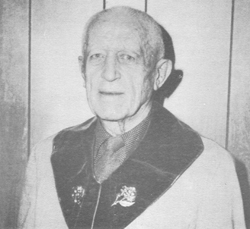
Harold Van Buren Voorhis was a chemist, noted Masonic author, and executive at Macoy Publishers and Masonic Supply Company.

Martin Augustine Knapp was a United States Circuit Judge of the United States Commerce Court, the United States Court of Appeals for the Second Circuit, the United States Circuit Courts for the Second Circuit and the United States Court of Appeals for the Fourth Circuit.
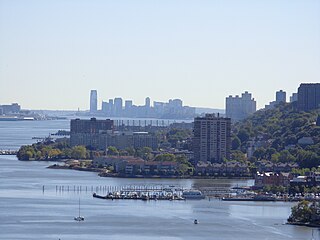
The Hudson Waterfront is an urban area of northeastern New Jersey along the lower reaches of the Hudson River, the Upper New York Bay and the Kill van Kull. Though the term can specifically mean the shoreline, it is often used to mean the contiguous urban area between the Bayonne Bridge and the George Washington Bridge that is approximately 19 miles (31 km) long. Historically, the region has been known as Bergen Neck, the lower peninsula, and Bergen Hill, lower Hudson Palisades. It has sometimes been called the Gold Coast.

The North Hudson Railway Company built and operated a streetcar system in Hudson County and southeast Bergen County, New Jersey before and after the start of the 20th century. It was founded by Hillric J. Bonn who became the first President in 1865 and served for 26 years until his death, and eventually taken over by the Public Service Railway. In its endeavors to overcome the formidable obstacle of ascending the lower Hudson Palisades, or Bergen Hill, it devised numerous innovative engineering solutions including funicular wagon lifts, an inclined elevated railway, an elevator and viaducts.
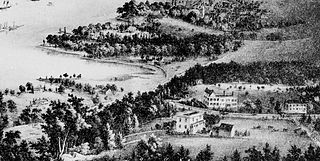
The Mountain Pavilion was an inn located in Weehawken, New Jersey during the 19th century.

Morsemere is a neighborhood in Bergen County, New Jersey, United States, largely in the northern part of Ridgefield and straddling the border of Palisades Park south of start of U.S. Route 46.

Englewood is a former railroad station at Depot Square in Englewood, New Jersey. Once served by the Erie Railroad's Northern Branch, the building is located in the city's town center along the ROW now used as a branch line by CSX Transportation. The station at Depot Plaza was one of the original stations upon opening of the Northern Railroad of New Jersey, which included two others in the town, Van Brunts and Highwood. The building has undergone various incarnations as restaurants, a recording studio, and a performing arts school. The proposed Northern Branch Corridor Project extension the Hudson–Bergen Light Rail would pass the station along the line.
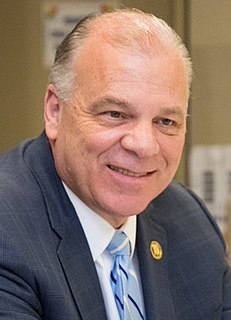
The 2021 New Jersey State Senate election will be held on November 2, 2021. New Jersey voters will elect state senators in all of the state's legislative districts for a two-year term to the New Jersey Senate.
References
- This article incorporates text from a publication now in the public domain : Rines, George Edwin, ed. (1920). . Encyclopedia Americana .